Islamic art spans over 1400 years, beginning in the seventh century and consists of painting, calligraphy, and decorative arts such as ceramics and metalwork. Islamic art is not specific to a geographic location, or Islamic countries, but a is fusion of Arab, Turkish and Persian cultures with global influence.
Notable Islamic Artwork
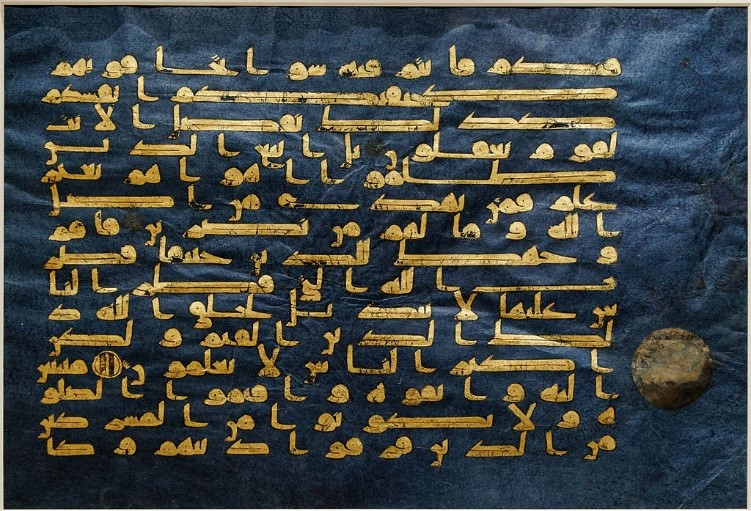
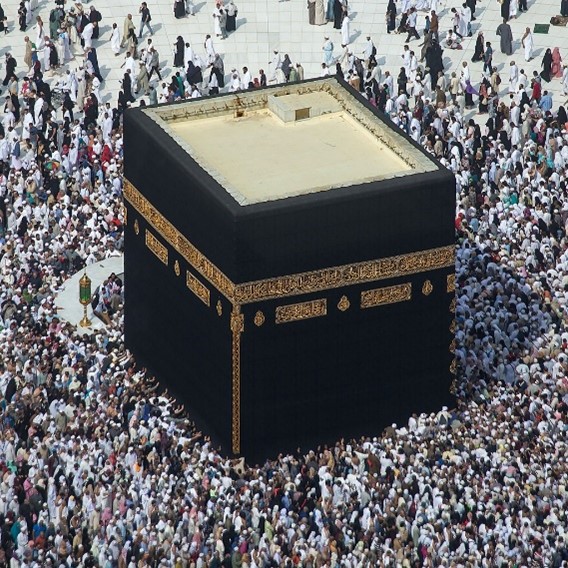
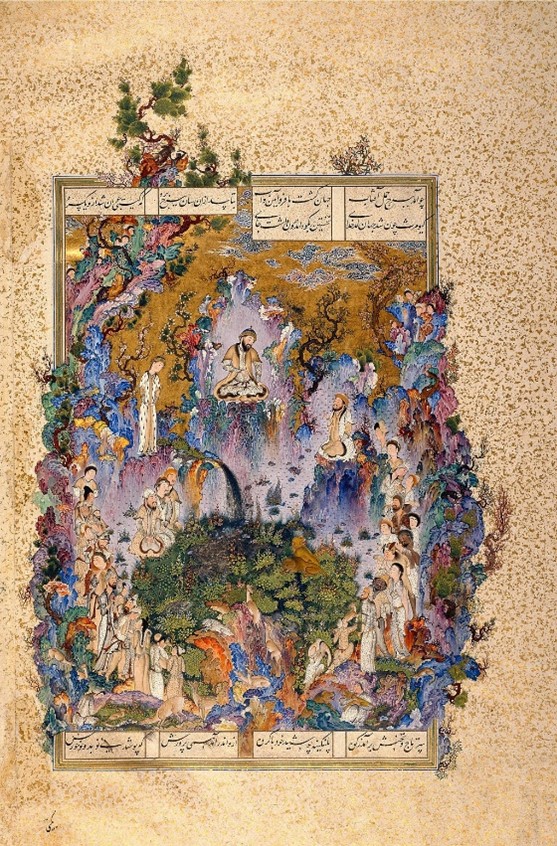
https://agakhanmuseum.org/collection/artifact/court-of-kayumars-akm165
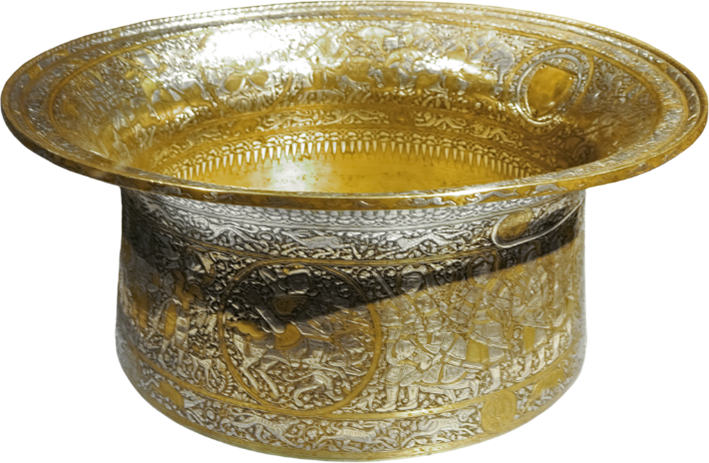
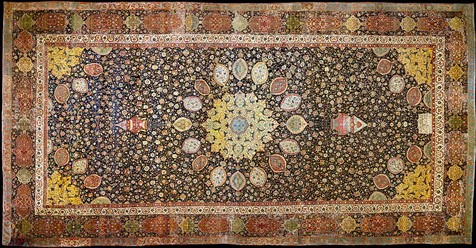
https://www.vam.ac.uk/articles/the-ardabil-carpet
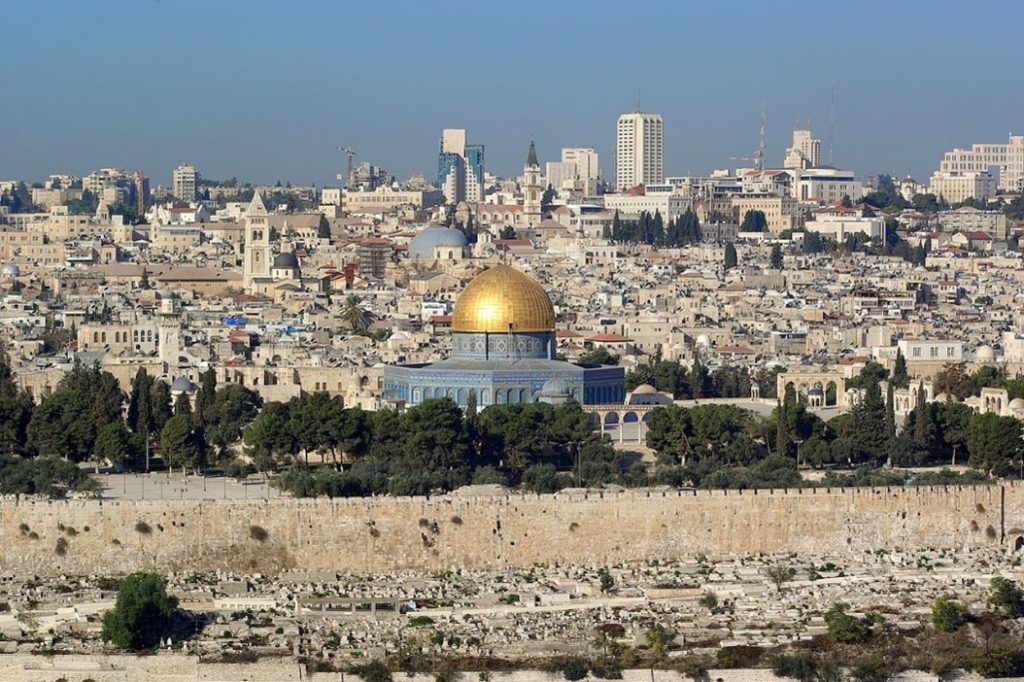
Dome of the Rock. 691. Shrine in Jerusalem
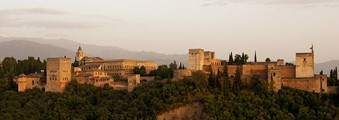

Religious Influences in Islamic Art
Religion is the most important part in Islamic art. In the Muslim world everyone spoke Arabic, they all assembled at the mosque facing Mecca. The Quran was revealed to Muhammad via the Angel Gabriel from God.
There are five pillars of Islam, which are:
- Profession of Faith (shahada) “There is no god but God, and Muhammad is the Messenger of God”
- Prayer (salat) Prayers toward Mecca five times a day.
- Alms (zakat) Giving a portion of money to charity.
- Fasting (sawm) Fasting in the daylight hours of Ramadan.
- Pilgrimage (hajj) Travels to Mecca at least once in a lifetime.
Pre-Islamic Traditions in Art
Islamic art is influenced by pre-Islamic traditions. The Arabs developed the Koran (Qur’an) and the Arabic form of writing. The sense of mathematics they studied from the Romans was essential for architecture, and geometric principals. The Turkish brought figurative and non-figurative design from Eastern and Western Asia. They also incorporate both early Christian and Byzantine art into architecture. The Persians brought poetry and literature which many works of art were based upon.
Islamic art developed through a combination of all of these element resulting in visual arts, decorative arts, architecture and the arts and crafts that make up the Islamic world.
Themes in Arts of The Islamic World
Calligraphy has always been viewed as the highest art form in Islamic art, as it communicated the words or God as revealed in the Koran. It is found in everything from books to inscription on decorative arts and even architecture.
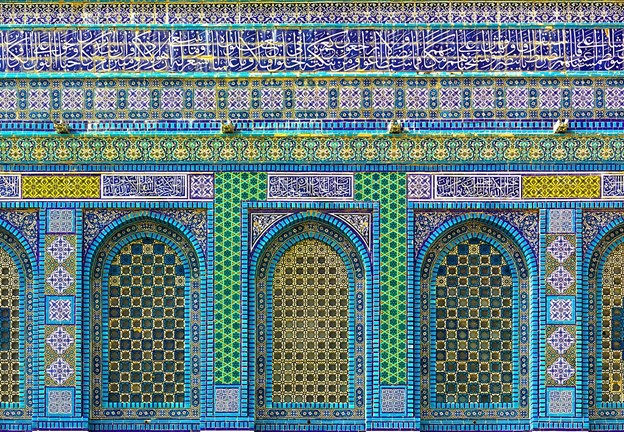
Floral motifs and trees also provide themes for decorative elements. The arabesque is most associated with art of the Islamic world. It is based on a leaf-scroll pattern with a stem, leaf, and blossom in endless variations.
Geometric designs include stars and lozenges, or diamonds that appeared after the 9th century. By the 13th century, these stars had between six and 13 points. Afterwards, stars in Islamic arts became even more elaborate with 14 and even 16 points. Unity is a theme expressed through art using geometric patterns and tessellation or the repetitiveness of design most notably in wall décor.
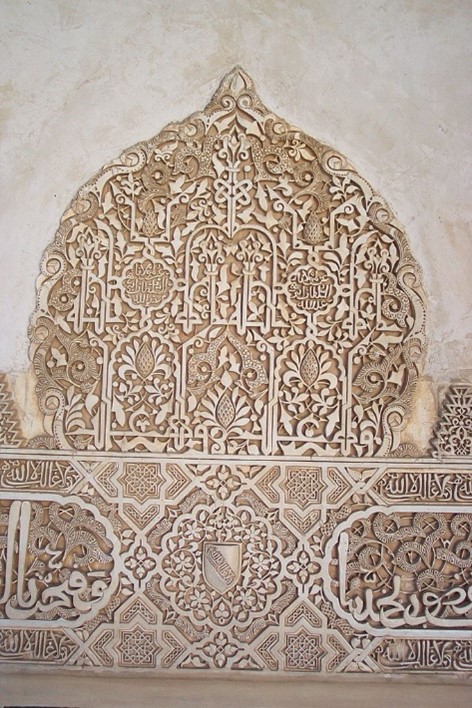
Mosques and Islamic Culture
Mosques are the most easily recognizable Islamic architecture, used for prayer, worship and as a community gathering place. Although constructions and styles of mosques vary greatly there are many common architectural elements. The dome or quibba represents the vault toward heaven. The minaret is a tower from which prayer is called. Some mosques have multiple domes and towers.
Most mosques have a courtyard where people can meet and there is always a fountain to wash at before entering the mosque for prayer. Once inside, there is a mihrab or niche, which indicates the direction of Mecca where prayer is directed. Mecca is called qibla, so this is often referred to as the qibla wall.
Early Islamic Art
During the Umayyad Caliphate Period (661–750) new Islamic architecture was created during this period including Dome of the Rock shrine in Jerusalem (691) and Great Mosque of Damascus (706).
Dome of the Rock is one of the oldest and best-known work of architecture. The design has a prominent gilded wooden dome sits that an octagonal base. Great Mosque of Damascus or Umayyad Mosque (706) is the oldest stone mosque that still survives.
These architectural buildings provided Islamic artists the opportunity to create some of the first Muslim art unique to the Islamic world.
Medieval Period Islamic Art
The medieval period of Islamic art lasted between 900 and 1517. After the Abbasid (750–1258) people conquered the Umayyads, Baghdad became the capital. Here new elements in Islamic art and architecture were founded including the arabesque, carved surfaces in the beveled style, elaborate use of color and luster painting.
There were many shifts politically in the Medieval Islamic world. The Fatimids (909-1171) took control of Egypt, Sicily, Algeria, Tunisia, and parts of Syria. Islamic metalwork began with simple functional pieces made from brass. Birds and animal were decorative elements.
The Seljuq Turks from Central Asia founded the Seljuk Sultanate (Turko-Persian Sunni) and controlled Iran, Iraq, and Syria, in in 1055. Then Mamluks controlled Syria and Egypt until 1517.
Genghis Khan (c. 1162-1227) and the Mongols invaded and later controlled West Asia. When he died in 1227, his empire extended from China’s Pacific coast to Eastern Europe. Before this the warring Kingdoms had made the Silk Road dangerous to navigate. The result of the reopening enabled vast cultural exchange. East Asian artistic elements were adapted into Perso-Islamic traditions and Islamic art.
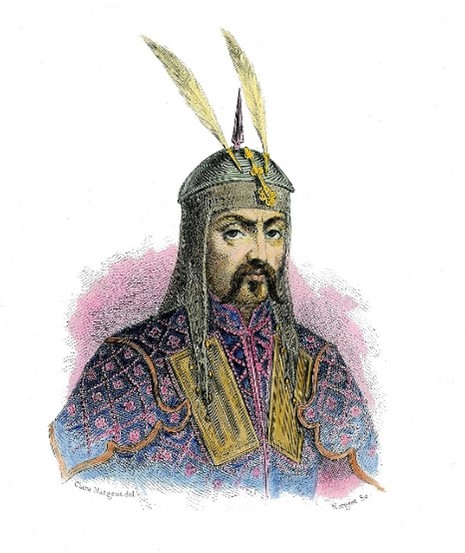
During the Ilkhanid Period (1256–1353) decorative arts began to flourish, most notably metalwork and ceramics. Artisan crafted textiles became more sophisticated. Both illustrated books and illuminated manuscripts gained popularity in Islamic art.
The Timurids or Tamerlane (1370-1507) built momumental architecture across the lands they controlled including Central Asia, greater Iran, and Iraq, and parts of southern Russia and India.
Umayyad Period in Spain (711–1469)
The Umayyads were not to be discouraged and fled to Spain. Here, Islamic arts of the Islamic world flourished, in what became known as Muslim Spain. Abd al-Rahman I 756 – 788 made Córdoba his capital and it became the intellectual capital of Europe.
Alhambra Palace (1354 – 1393)
The Almoravids (1062–1150), The Almohads (1150–1269), The Nasrids (1232-1492) would also rule the southern Iberian Peninsula and western North Africa and continue to create Muslim art. Alhambra Palace from the Nasrid Dynasty built between 1354 – 1393 stands in Granada, Spain. The former royal palace still has a fortress, residence, pavilions, and gardens, even though parts have been demolished.
Spain’s political power and the union of Ferdinand and Isabella would end Islamic rule in the 15th century.
Islamic Art Later Period (1517 –1924)
This period is the era of the last great Islamic Empires. The Ottoman Empire ruled between 1281 up until WWI building beautiful mosques in the 15th and 16th century. Arts flourished under the Safavid between 1501-1722 and they were especially renowned for carpets.
The Taj Mahal (1632-1653)
The Mughals (1526-1858) created some of the greatest examples of illuminated manuscripts and painting, as well as architecture including Taj Mahal. The Islamic mausoleum, in Agra, Uttar Pradesh, in Northern India created under the supervision of architect Ustad Ahmad Lahori was built between 1632-1653. The Indo-Islamic architecture is made from stone and marble with intricate décor and Muslim art. The extensive gardens, sitting on 42 acres are in Persian style.
Calligraphy
Islamic art is inspired by religious messages and captures the words on God through calligraphy. Traditional Islamic calligraphy is made up of two styles–Kufic and Naskhi. Kufic, an angular script, is the oldest and was the only form during the first five centuries. There are eight variations. Naskhi appeared in the 11th century and soon replaced Kufic.
Calligraphy in Islamic arts was not only used for religious text within religious art. It was also used to record lines of poetry or to signify ownership.
Religious Art: Calligraphy and the Koran
Folio from a Qur’an created in the 8th to 9th and produced in North Africa or Near East is an Abbasid Islamic religious text, written in Kufic style, now in the Morgan Library in New York.
The lavish work was created with expensive materials including parchment paper from the skin of sheep of goats and gold. Brown ink was used for writing and red dots used to indicate vowels. Ink color and gold were used.
Folio from the “Blue Qur’an” a religious art creation from the 9th to mid -10th century has pages dyed indigo with silver verse in calligraphy. This is a rare example of a Qur’an in Islamic arts due to the paper’s color.
Islamic buildings almost always have an inscription, either a quote from the Koran or a single word, which may be appear repetitively. All correspond to the shape and size of the building.
The Kaaba, the cube shaped, holiest site in Islam, located in Mecca, Saudi Arabia was constructed between 631-632. The building is wrapped in a silk curtain made of silver and gold threads, with messages written in Arabic calligraphy.
Visual Art: Islamic Painting in the Islamic World
Painting throughout the Islamic world has been dominated by book painting and miniatures. In the late medieval times illuminated manuscripts emerged. These were often commissioned by members of the royal family. The Court of Kayumars (1524-1525) is a folio or page from the illuminated manuscript Shahnameh (Book of Kings) of Shah Tahmasp.
Made by Sultan Muhammad, a master artist, on fine paper with gold and watercolor, with 285 illuminations. Shah Tahmasp was the Safavid ruler, and the book tells the story of Persian Kings with mythical content. The Court of Kayumars is considered a prime example of Islamic book painting.
Miniatures were small painting based on artistic traditions in Persia. The Mughals of India painted realistic images, while the Ottomans preferred stylized forms. These works were collected together to form a Murraqqa or book of visual art.
Jahangir Preferring a Sufi Shaikh to Kings or Jahangir Enthroned on an Hourglass (1615-1618) is a visual art Islamic miniature by artist Bichitr, a famous Hindu painter in the Mughal court, using watercolor, gold, and ink. The painting is full of symbols and adapts European motifs and forms combining both Islamic and European elements.
The Islamic Art of Ceramics
Luster painting developed in Egypt and Syria in the 8th century. Tiles were painted with a glaze that contained silver and oxide, which upon firing this created a glossy surface.
The people of Bagdad became masters of the luster painting technique. They also began experimenting with tin glaze to capture the white of imported Chinese wares and porcelain. They were unable to achieve the levels of heat required for this to occur and instead works were left with a yellow tinge. The solution was tin glaze containing tin oxides.
During the 8th century the Hispano-Moresque style emerged in Islamic Spain. This was the result of two ceramic techniques. They created tin glaze using various metal oxides to achieve color such as blue, green, purple, and brown. They also used luster painting most notably in blue. The highly ornate styles were in demand across the Muslim world and Europe.
Meanwhile, in the 9th century ceramic production started to rise with Iraq as a top producer and were responsible for producing the tiles for Great Mosque. Soon production spread throughout the Muslim world. Carved ceramic began to appear that exposed the red clay underneath using a technique called sgraffiato.
The Seljuks (1038-1327) were working with faience using 10 parts powdered quartz with one part glaze and one part clay. This allowed potters easier manipulation and a more refined finished product.
In the Post-Medieval period Iznik pottery produced in Ottoman Turkey were influenced by Chinese blue and white pottery.
Islamic Art in Metalwork
The high point of Islamic metalwork began with the inlay technique. Hard metal such as bronze or brass were inlaid with softer metals that included silver, gold, and copper. Anthropomorphic and zoomorphic elements were added to the Arabic script on the vessels
Basin (Baptistère de St. Louis) constructed from brass with gold and silver inlay was made between 1320 and 1340. It shows a battle scene between the Mamluk and their enmenies the Mongols. Decorative sea life appears in the form of fish, eels, frogs, and crabs.
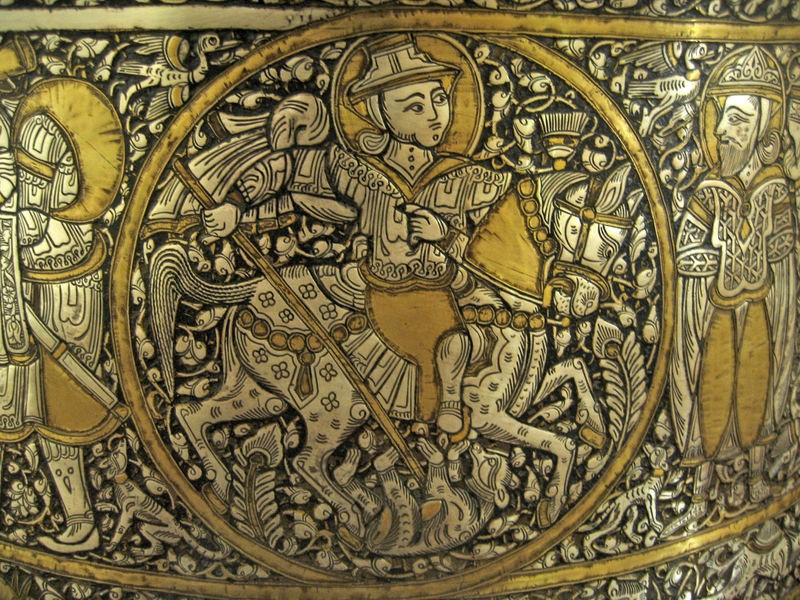
Initially the bowl was used as a washing vessel, but somehow ended up in France and was used by the royal family for baptism making it a piece of religious art.
Islamic Art in Glass Making
Glass making was important during the early Middle Ages and was considered a luxury art. Mosque lamps were in great demand.
Artists between the 8th and 11th century experimented with creating decorative glass by carving and later creating reliefs. Luster painting on glass involved adding metal during the glassmaking process. Threads of glass were also used. Soon glass became gilded, painted, or enameled. Islamic glass fell out of favor when the Venetians perfected the craft.
Islamic Art in Textiles
Islamic textiles fall under the category of arts and crafts. Batiks and carpets dominate. The making of batiks is a pre-Islam technique from Indonesia requiring multiple dying processes. Once the fabric absorbs the color the artisan desires, it is coated with wax, preventing it from absorbing any additional color in subsequent dyes. Most images are aniconic while others have images from pre-Islamic mythology.
The weaving of carpets was important to the Ottoman empire. These were intricately knotted silk and cotton works that gained international fame, until the end of the empire in 1922.
During the Iranian Safavid Empire (1501-1786) textile arts flourished. The Ardabil Carpet is a fine example from Safavid Dynasty crafted between 1539-1540 CE. This prayer rug is classified as a Northwest Medallion Carpet, which is one of more than two dozen types of Persian carpets. Floral, vegetative, and geometric make up the design of this carpet that contains 10 colors. It is one of the oldest Islamic carpets in the world.
Mosque Styles
There are four styles of mosques main styles of mosques: hypostyle, four-iwan plan and the centrally- planned mosque.
Hypostyle Mosques in the Islamic World
The first official mosque was the home of Muhammad. Soon other mosques were built in the Hypostyle style. One early example of a well-preserved mosque in this style is Great Mosque of Kairouan, in Tunisia, built in 670. The long stone structure has a hypostyle prayer hall supported by columns, with along courtyard. A defining element of this hypostyle style mosque are the numerous columns inside. These are spoila from the Byzantine site it was built upon.
The stone masonry built Great Mosque of Córdoba (785-786), in Córdoba, Spain is an example of a Moorish hypostyle mosque. Constructed on stone. Note the over 500 double-horse-shoe arch columns with red and white alternating voussoirs and Roman spoila.
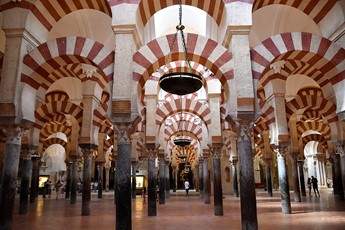
Development of Four-Iwan Mosques
The word iwan is derived from the Persian word ban meaning house. This is a vaulted space that opens on one side to a courtyard. During the 11th century the four-iwan plan opened on all sides. In this style of architecture, the qibla wall is the one that is most decorative.
The Centrally Planned Mosque in the Islamic World
The Ottoman Empire founded in 1299 was not dominated by the four-iwan plan but instead favored the centrally planned mosque. The Hagia Sophia, once a Byzantine church, was converted to mosques by the Ottoman Turks, when the Byzantine empire fell in 1453. The church featured a gigantic dome over a nave. This was kept and four minarets were added. Many mosques were influenced by this renovation.
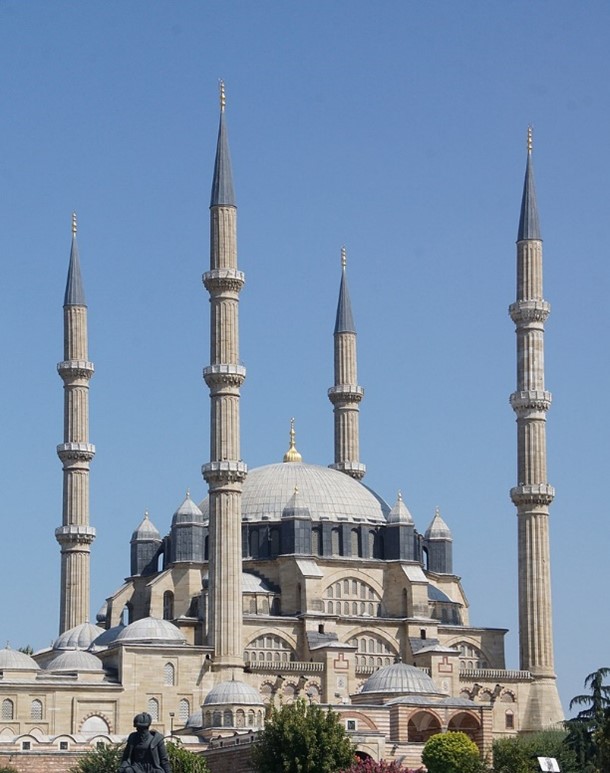
Master architect Mimar Sinan referenced the Hagia Sophia with his skills culminating in Mosque of Selim II, (1569-1575) in Edirne, Turkey. The main dome was crafted to be higher and wider, with 18 smaller domes. Minarets in all four corners have three balconies each.
The dome rests upon 8 piers. The architect used squinches to transfer a circle into an octagon. There is aniconic decoration with mosaic tessellation, or repetition of geometric design and alternating red and white voussoirs.
Related Art Terms
- Calligraphy
- Calligraphy
- Kufic
- Naskhi
- Aniconic
- Arabesque
- Lozenge
- Tessellation
- Quibba
- Minaret
- Mihrab qibla
- Qibla wall
- Hypostyle
- Iwan
- Four-iwan plan
- Centrally planned mosque
- Spoila
- Voussoirs
- Squinches
- Piers
- Beveled style
- Luster painting
- illuminated manuscripts
- Murraqqa
- Tin-glaze
- Metallic lusters
- Sgraffiato
- Northwest Medallion carpet
